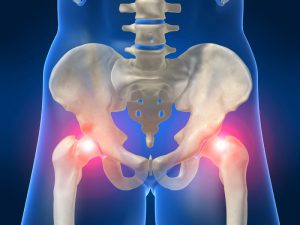Hip Disorders
Most of these cases involve hip replacement because of the hip  wearing down (avascular necrosis of the femoral head). Hip fractures and birth defects also make up this category of cases. Standing and sitting for even short periods of time can be difficult. The hip joint is, by far, the largest joint in the body. One of the most crucial elements to proving your case before the Social Security Administration, is to show the pain level on a day-to-day basis. Many people with hip disorders complain of severe constant pain that prevents any work. Usually a very strong case can be made that the pain by itself is a disabling.
wearing down (avascular necrosis of the femoral head). Hip fractures and birth defects also make up this category of cases. Standing and sitting for even short periods of time can be difficult. The hip joint is, by far, the largest joint in the body. One of the most crucial elements to proving your case before the Social Security Administration, is to show the pain level on a day-to-day basis. Many people with hip disorders complain of severe constant pain that prevents any work. Usually a very strong case can be made that the pain by itself is a disabling.
The ideal evidence is an opinion from the treating orthopedic doctor describing the ability to walk, sit, and stand supported by an objective medical test. When the ideal evidence is presented, this makes for a very strong case for disability for people who are 50 and older. The following tests can help pinpoint the proper diagnosis.
Imaging tests:
| X-rays | Usually appear normal in the early stages of avascular necrosis; can show bone changes that occur in later stages of avascular necrosis. Can show bone changes in general |
| Bone scan | Small amount of radioactive material is injected into the vein. This material travels to the parts of your body that are injured or healing. Bright spots show up on imaging. |
| MRI | Can show early changes in the bone that may indicate avascular necrosis or other hip problems |
The Social Security Administration will want to see some sort of objective medical evidence as contained in the chart above. X-rays, bone scans, and MRIs provide a factual basis for the doctors opinion, thereby bolstering the doctors credibility.
What Our Clients Say:
Member:

Attorney Gregory Kornegay
Greg is a trial attorney in Wilmington with over 30 years of experience. Greg was born and raised in southeastern North Carolina. Before law school he managed a store with employees making a payroll every week. His first job out of law school was as an Assistant District Attorney investigating and trying cases for the State of North Carolina. Through the years he has handled many different types of cases – including death penalty cases.
Being married with children has been a blessing and a challenge, but has served him well in understanding the problems individuals and families face as they live out their lives. Greg believes that each case is different and the needs of each client are unique, but there are certain themes of life that we all share.


